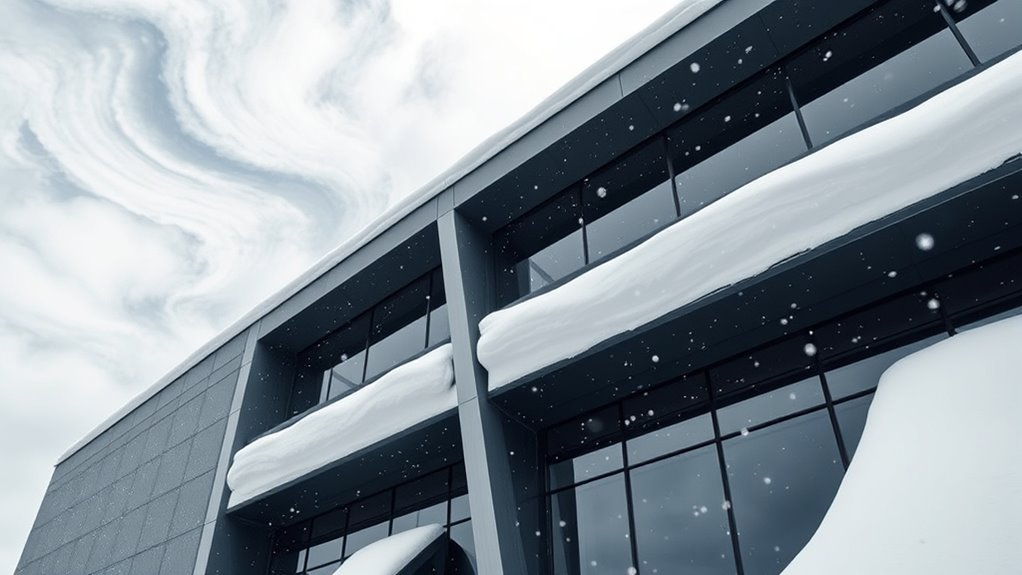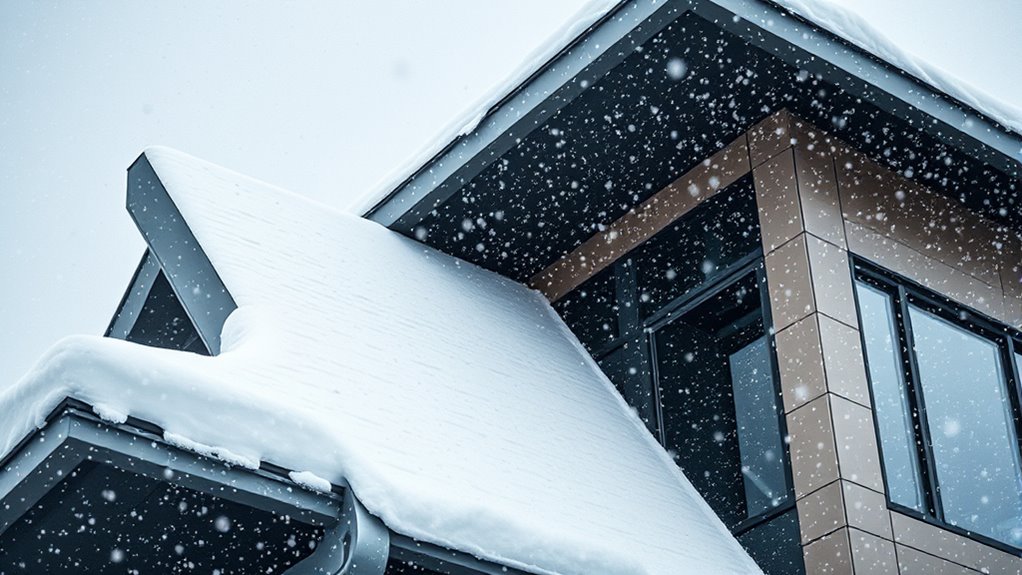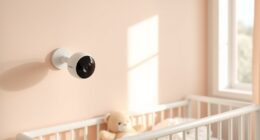When designing for snow and wind loads, you should consider local climate data, roof slope, and material strength to handle snow accumulation safely. Incorporate steep roofs and snow guards to prevent dangerous buildup, and use aerodynamic shapes to reduce wind pressure. Reinforce connections and foundations to resist uplift and lateral forces. By applying proper calculations and standards, you can create resilient structures that withstand extreme weather. Keep exploring to learn how to optimize your design for these challenges.
Key Takeaways
- Incorporate local snow load data and safety factors into structural design to accommodate maximum expected snowfall.
- Design roof slopes and pitches to facilitate snow sliding off, reducing accumulation and load.
- Use aerodynamic shapes and wind-resistant features to minimize wind pressure and uplift forces on the structure.
- Reinforce connections, anchoring, and foundation systems to withstand lateral wind forces and snow-induced stresses.
- Schedule regular inspections and maintenance to identify weather-related vulnerabilities and ensure ongoing structural resilience.

When designing structures in regions prone to snow and wind, it’s essential to understand how these loads influence your building’s safety and performance. Snow accumulation can quickly add significant weight to roofs and other horizontal surfaces, increasing the risk of structural failure if not properly accounted for. The amount of snow that gathers depends on local climate, roof design, and surface characteristics. Heavy snow loads can cause stress and deformation, so your design must include appropriate load-bearing capacities to handle worst-case scenarios. Wind pressure also plays a critical role, exerting force on the building’s surfaces and creating lateral stresses that can compromise stability. Wind’s impact varies with speed, direction, and the building’s shape, making it necessary to analyze these factors during planning.
Designing for snow and wind loads ensures structural safety and durability in harsh climates.
To effectively manage snow accumulation, you should consider roof slopes that promote snow sliding off rather than building up. Steeper pitches reduce snow load, but you must balance this with aesthetic and functional considerations. Incorporating durable, snow-resistant roofing materials helps prevent leaks and damage caused by melting and refreezing cycles. Additionally, integrating snow guards or barriers can control snow release and prevent dangerous avalanches from falling suddenly. When calculating snow loads, use local snow load data and apply safety factors to account for variability in snowfall and accumulation patterns. Remember, snow loads are not static; they can intensify during storms, so your structure must withstand sudden increases in weight.
Addressing wind pressure requires designing with aerodynamics in mind. Your building’s shape and orientation influence how wind forces are distributed. Streamlined designs reduce wind resistance, lowering pressure on walls and roofs. Reinforcing connections and anchoring systems ensures your structure resists uplift and lateral forces, especially during storms. Consider installing windbreaks or vegetative buffers to reduce wind speed around the building, which can help decrease pressure and protect the structure. When analyzing wind loads, consult local wind maps and standards to determine typical and extreme conditions. Properly designed bracing, shear walls, and foundation anchoring enhance stability under high wind pressures.
Ultimately, your goal is to create a resilient structure that can handle the dual challenges of snow accumulation and wind pressure. By understanding these forces and integrating appropriate design strategies, you ensure safety, durability, and performance. Regular maintenance and inspections further help identify potential vulnerabilities caused by snow and wind over time. This complete approach not only protects your investment but also provides peace of mind during harsh weather conditions.
Frequently Asked Questions
How Do Snow Loads Vary With Different Roof Shapes?
You’ll notice snow loads vary with roof shapes—steeper slopes shed snow more easily, reducing load, while flatter roofs accumulate more. The roof slope influences how snow settles, so consider insulation strategies that keep heat inside, preventing snow melt and refreeze cycles that add weight. A well-designed slope and insulation plan help manage snow loads effectively, ensuring your roof stays safe under varying winter conditions.
What Materials Best Resist Wind-Driven Snow Accumulation?
You want materials that resist wind-driven snow accumulation? Opt for durable, tightly sealed materials like metal roofing or high-quality membranes, which prevent snow infiltration and withstand harsh conditions. Pair these with effective insulation strategies to minimize temperature differences that cause snow buildup. Using robust materials guarantees longevity, reduces maintenance, and keeps your structure safe from the relentless forces of wind and snow.
How Can Building Design Minimize Wind Uplift?
You can minimize wind uplift by optimizing your building’s aesthetic aesthetics and ensuring structural stability. Use aerodynamic shapes and low-profile roofs to reduce wind pressure. Incorporate proper anchoring systems and secure roofing materials to resist uplift forces. Additionally, consider windbreaks or barriers that redirect airflow. These strategies help maintain your building’s aesthetic appeal while enhancing its resilience against wind uplift, ensuring long-term structural stability.
Are There Specific Codes for Extreme Snow and Wind Events?
You should know that specific codes, like ASCE 7 or IBC, address extreme snow and wind events. For example, a recent case study shows how building insulation and structural reinforcement were designed to meet these standards, ensuring safety during rare storms. These codes guide you to incorporate appropriate materials and structural techniques, helping your building withstand severe loads while adhering to safety regulations. Always consult local codes for your region’s requirements.
How Do Climate Changes Affect Load Calculations Over Time?
Climate changes can greatly impact your load calculations over time. You should incorporate climate adaptation strategies by updating load forecast modeling regularly to account for evolving weather patterns. As extreme snow and wind events become more frequent or intense, these adjustments ensure your designs remain resilient and compliant with safety standards. Staying proactive allows you to better predict future loads and adapt your structures accordingly.
Conclusion
When designing for snow and wind loads, you must stay vigilant and adapt like a seasoned explorer steering the wild frontier. Remember, ignoring these forces is as risky as trusting a dial-up connection in the age of fiber optics. By carefully considering these loads, you ensure your structure withstands nature’s wrath, just like a well-built fortress in a fairy tale. Don’t forget—precision and foresight today save you from a castle’s collapse tomorrow.










